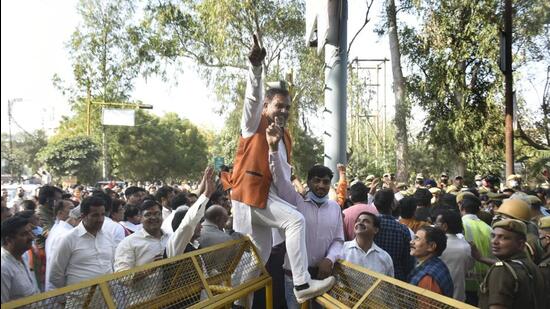Focus on law and order, other communities helped BJP counter Jat anger in west UP
By January, staring at the possibility of the Jats rallying around the RLD, the BJP had to sharpen its campaign in the region to stem its losses
When the assembly elections to India’s most populous and politically significant state commenced on February 7 from districts in western Uttar Pradesh, the Bharatiya Janata Party (BJP) faced significant headwinds in the form of Jat anger, fuelled by a 14-month-long farmer agitation against three farm laws.

Come March 10, however, evidence suggests that the BJP was able to neutralise the anger in the region by repealing the laws more than three months ahead of the elections, focusing on law-and-order in an area scarred by the 2013 Muzaffarnagar riots, quelling the extent of Jat anger, and targeting their campaign on other communities that have continued to back the BJP. While the Samajwadi Party-Rashtriya Lok Dal (SP-RLD) combine made some dents in areas where the farmer anger was highest, a counter consolidation helped the BJP sail through.
Of the total 136 seats that went to the polls in the first two phases, the BJP won 93, SP-RLD 43.
By January, staring at the possibility of the Jats rallying around the RLD, the BJP had to sharpen its campaign in the region to stem its losses. “The campaign got off to a flying start when home minister Amit Shah went door-to-door campaigning in Kairana. The impact of that move galvanised the cadre and also helped blunt the Jat community’s anger,” said a senior party leader. The choice of Kairana as the starting point for Shah’s campaign was perceived as a move to tackle what had emerged as a challenging demographic for the party.
Kairana hit the headlines in 2017 when the BJP’s then MP, Hukum Singh, alleged an exodus of Hindu families from the area. Shah met some of these families that had moved out following alleged communal tensions in the area which has 1.7 million voters including over 300,000 Muslims.
“The BJP kept the focus on the improved law-and-order in the state; how crime rate had fallen and how swift action was taken against offenders. And since this is an issue that affects every caste and class, the BJP could prevent the SP-RLD combine from cashing in on the negative sentiments,” the BJP leader quoted above added.
Through the course of the election campaign, while there were signs of a return of the Jats to the RLD-SP combine, but a combination of the repeal of the three farm laws by the Union government and the memory of the Muzaffarnagar riots in the SP regime reduced the extent of the shift. While there were gains for the Opposition in the districts of Muzaffarnagar, Meerut and Shamli, with high-profile BJP candidates Sangeet Som and state minister Suresh Rana both losing, the impact of the farmers’ movement failed to undermine the BJP’s vote bank in Saharanpur, Bulandshahr and Hapur districts.
Farmer leaders said that while the effects of the farm agitation, and the unification of the Jat-Muslim vote was clear in seats such as Siwalkhas in Meerut, which was won by Ghulam Mohammad of the RLD, the broader portrayal of the farm movement as just a Jat issue hurt the opposition.
“This perception, aided by sections of the media, helped the BJP in its performance despite people’s anger,” BKU (Asli) president Harpal Singh Bilari said.





